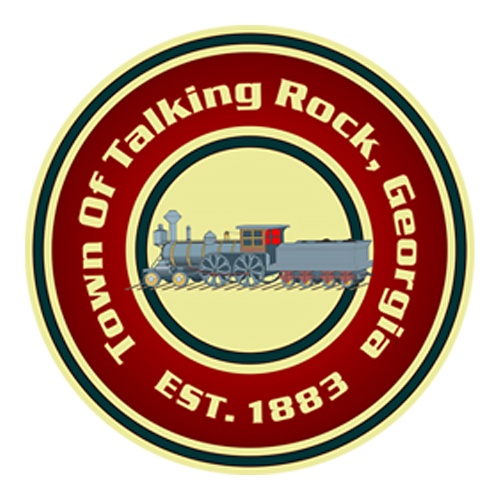
Talking Rock Park is a great family place to come and enjoy a picnic by the creek. Park features a pavilion, clean restrooms, playground equipment, picnic tables, grills, trees and room to play. It’s a great spot to relax any day of the year!
Park Development was assisted with funds from the Land and Water Conservation Fund thru the Georgia Department of Natural Resources - Divisions of Parks and Historic Sites and the U.S. Department of Interior - National Park Service.
PARK PAVILION
$75 for 4 hours | $75 deposit required
LIMITED TO 50 PATRONS
(ALL FEES MUST BE IN CHECK FORM NO CASH OR MONEY ORDER ACCEPTED)
COMMUNITY ROOM
$100 for 4 hours
$100 deposit
(ALL FEES MUST BE IN CHECK FORM
NO CASH OR MONEY ORDER ACCEPTED)
The purpose of the Talking Rock Schoolhouse Teaching Museum is to preserve a historic schoolhouse so that future generations can appreciate early life and education in the Appalachian foothills.
This building was originally Ludville High School and was located in Ludville, in the west end of Pickens County. The building was constructed in 1877 and was the first high school in the county. Despite being in Ludville, the school was patronized by people from all parts of the county and other counties. Families in the area operated boarding houses to help accommodate the students.
Due to financial difficulties, the school was sold by Newborn W. Black to Chesley Vincent, who was an educator. Professor Vincent operated the school at Ludville for a time. When the railroad came to Talking Rock, Professor Vincent moved the school to Talking Rock. He felt the school would be more available to students being closer to the railroad.
From 1883 to sometime in the 1930’s this building served as a schoolhouse for the children in the Talking Rock area. It was known then as Talking Rock Academy.
The original building was a two-story structure. The Odd Fellows Society occupied the second floor of the building for some time after it was moved to Talking Rock. The Odd Fellows Society was a fraternal organization that helped to protect and care for the poor and less fortunate in their community. There was no welfare system then.
In the early 1930’s, the second floor of the building had to be removed because of heavy winds and storm damage. The men in the community thought it was best to remove the second story, and they used a strong cable to try to straighten the building. However, today there is still a small amount of lean to the building.
From the late 1930’s until the mid 1970’s the building served as a community building. Sunday School was held here. Christmas plays, Vacation Bible Schools, Halloween carnivals, meeting of the Talking Rock Homemakers’ Club, miscellaneous showers, and even precinct voting took place in this building.
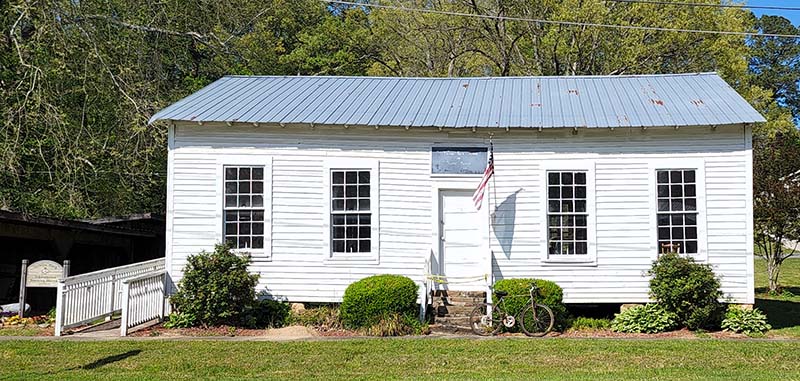
The school year did not start until the first part of September and would last for 8 months. The school day started around 8:00a.m. and ended at 3:30p.m. The school day opened with a prayer. In this schoolhouse, there was a curtain that divided the “little room” for Primer to 4th Grade from the “big room” for 5th through 7th grades. The teacher’s desk was up on a platform, stage-like area so the teacher could see the class. Each desk sat two students, and you could choose your partner as long as you behaved.
Heat was provided by a two-eyed burner wood stove. The older students would usually come a little early in the morning to start the fire in the stove so the building could begin warming up. The restrooms were located outside. There was an out-house for the boys and one in a different location for the girls.
There was an hour allowed for lunch. Lunches were brought from home in sacks, lard buckets, or wrapped in newspaper. The lunches were put in the corner out of the way until it was time to eat. There was a table with a water bucket. In the early days, all the students drank out of the same bucket and shared a cup or ladle. Obviously, they did not worry too much about germs.
There is a story that in 1889 the teacher, William T. Townsend, walked nine miles to the Talking Rock School. One day it was nine degrees below zero when he walked to the school. None of the students came that day.
Mr. Townsend built a fire, warmed up, and walked back home. During his first term, Mr. Townsend had enrolled 14 boys and 21 girls. He was paid about 5 cents a day, and he made about $30 for his work that term.
1877
Built in Ludville - Originally a high school
1882
Moved to Talking Rock to use
as a school for children
1930’s
Removed the second floor
1933
Closed the schoolhouse
1933 to mid-1970’s
Used as a community center
1975-1997
Stood dormant
1998
Restoration began
2002
Dedicated as a teaching museum
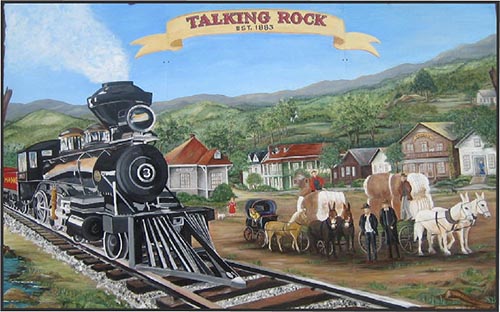
Mural by local artist, Mary Ann Manzel, assisted by Lynda Cagle and Michael Marchbanks
The train played a vital part in the lives of the residents by providing a source for shipping cotton grown in the community, mail delivery, and travel to other parts of the state. At one time the train came through town four times a day.
The railroad depot was sold to an employee of the railroad
for a small amount years ago.
The background, white 2 story house was the home place of J. R. Allen; it is believed that at some point the home was used as a boarding house.
The green 2-story building was purchased by the Hobson Family in 1924 and was operated as a General Store until around 1980. The store is operated today as an antique shop by a daughter of Mr. Hobson, Helen Low. In 1913, a large addition was put on the store and used as a hotel to house traveling sales men.
The brown l-story building was the home of Virgie Haggood and was referred to by locals as the Hat House, because Mr. Haggood was a milliner (hat maker) by trade.
The white building was built around 1930 and was home to Joe Simmons who raised his family there and operated a small country store.
Not much is known about the tavern. In the late 40’s a chenille bedspread factory was constructed on this site. In the early 50’s, Coke operated a warehouse business from our present day Town Hall which was remodeled in 1998.
The small white building served as the Post Office for many years. It is said that there was a doctor’s office behind the post office.
Above Main Street in the woods, you will find Talking Rock Church, which has an active congregation today.
At the far right you will find Talking Rock School House. It was built in 1877 in Ludville, moved to Talking Rock in 1882 and refurbished by retired teachers with grant funds in 1998.
People in the front row are depictions by the artist, Mary Ann Manzel, of the sheriff, doctor, and others individuals as they may have looked in 1883.
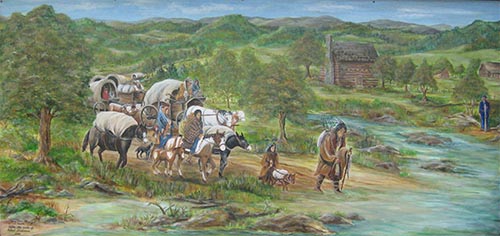
The Trail of Tears mural is mounted at the entrance to the Town Park on the side of the pavilion.
Local artist Mary Ann Manzel depicts the Cherokee Indians crossing Talking Rock Creek as they traveled in route to Fort Noonan.

4498 Hwy 136 West
Talking Rock, GA 30175
706-222-3630
www.boxcar-grill.com | @boxcargrilltalkingrock

4615 Hwy 136 West
Talking Rock, GA 30175
706-253-3040
lateral-drift.com
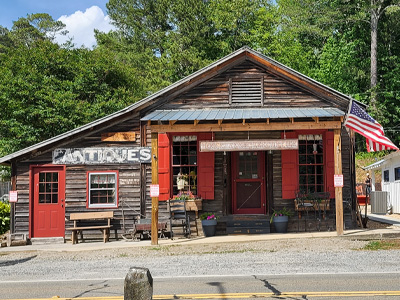
4551 Hwy 136 West
Talking Rock, GA 30175
706-253-2270
@mooseandannie
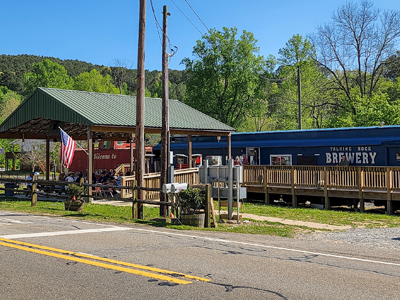
4500 Highway 136 West
Talking Rock, GA 30175
706-253-2337
talkingrockbrewery.beer | @talkingrockbrewery